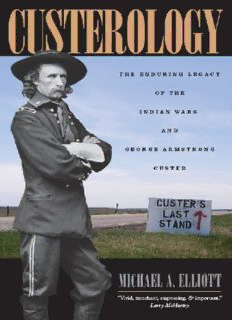
Custerology: The Enduring Legacy of the Indian Wars and George Armstrong Custer PDF
Preview Custerology: The Enduring Legacy of the Indian Wars and George Armstrong Custer
CUSTEROLOGY CUSTEROLOGY THE ENDURING LEGACY OF THE INDIAN WARS AND GEORGE ARMSTRONG CUSTER (cid:3) (cid:2) (cid:4) MICHAEL A. ELLIOTT THE UNIVERSITY OF CHICAGO PRESS CHICAGO AND LONDON The University of Chicago Press, Chicago 60637 The University of Chicago Press, Ltd., London © 2007 by The University of Chicago All rights reserved. Published 2007 Paperback edition 2008 Printed in the United States of America 17 16 15 14 13 12 11 10 09 08 3 4 5 6 7 ISBN-13: 978-0-226-20146-7 (cloth) ISBN-13: 978-0-226-20147-4 (paper) ISBN-10: 0-226-20146-5 (cloth) ISBN-10: 0-226-20147-3 (paper) Library of Congress Cataloging-in-Publication Data Elliott, Michael A. Custerology : the enduring legacy of the Indian wars and George Armstrong Custer / Michael A. Elliott. p. cm. Includes bibliographical references and index. ISBN-13: 978-0-226-20146-7 (cloth : alk. paper) ISBN-10: 0-226-20146-5 (cloth : alk. paper) 1. Little Bighorn, Battle of the, Mont., 1876. 2. Custer, George Armstrong, 1839–1876. I. Title. E83.876.C983E55 2007 973.8'2092—dc22 2007010880 (cid:2)(cid:2) The paper used in this publication meets the minimum requirements of the American National Standard for Information Sciences— Permanence of Paper for Printed Library Materials, ANSI Z39.48-1992. CONTENTS list of illustrations vii Introduction 1 one Ghost Dancing on Last Stand Hill 19 Crow Agency, Montana two Being Custer 59 Monroe, Michigan three Lives on the Plains 102 Cheyenne, Oklahoma four Into the Black Hills 147 Rapid City, South Dakota five Testimony in Translation 191 The Library six Little Bighorn Forever 224 Hardin, Montana • Garryowen, Montana Epilogue 273 Indian Country acknowledgments 283 notes 285 works cited 313 index 329 ILLUSTRATIONS Figure 1. Custer’s Last Fight by Otto Becker 34 Figure 2. The “burial of the hatchet,” 1926 38 Figure 3. Granite obelisk, Last Stand Hill 45 Figure 4. The Little Bighorn Indian Memorial, outside view 46 Figure 5. The Little Bighorn Indian Memorial, inside view 46 Figure 6. Custer in Harper’s Weekly, 1864 70 Figure 7. Romance of Monroe by Ralf Henricksen 89 Figure 8. The fi rst Washita monument, 1891 106 Figure 9. Cheyenne prisoners captured in Custer’s Washita attack 118 Figure 10. The frontier Custer, 1869 123 Figure 11. The Crazy Horse Memorial under construction in the Black Hills 167 Figure 12. Custer’s War by One Bull 198 Figure 13. “Here Fell Custer,” showing Crow scouts in 1909 212 Figure 14. Tony Austin as Custer in the Hardin reenactment 248 Figure 15. Steve Alexander as Custer in the Real Bird reenactment 255 Figure 16. Indian warriors crossing the Little Bighorn River on horseback in the Real Bird reenactment 268 (cid:3) (cid:2) (cid:4) INTRODUCTION WES ANDERSON’S 2001 FILM THE ROYAL TENENBAUMS BEGINS WITH ELI CASH describing the novel that has made him a literary celebrity, Old Custer. “Everyone knows Custer died at Little Bighorn,” Owen Wilson, who plays Cash, deadpans. “What this book presupposes is, maybe he didn’t.”1 It is a throwaway line to introduce the shallow intelligence of Cash, who parades for the literati in a fringed buckskin jacket and cowboy hat. We get the point: Cash is a one-trick pony who has been able to captivate the read- ing public by taking a simple fact of history and turning it on its head. He is right, after all, about one thing. Everyone does know Custer, and what everyone knows about Custer is that he died—famously, or maybe infa- mously, overwhelmed by a massive force of Indians at the Battle of the Lit- tle Bighorn. For most Americans, as for Eli Cash, Custer’s death has come to be regarded as something less than a historical event and something more like the punch line of a joke, and not even a very funny joke at that. This book tells a different story about Custer—a story that takes note of humorous allusions such as Eli Cash’s but that also tries to make sense of the locations in the contemporary life of the United States where Custer continues to be taken quite seriously. Indeed, Eli Cash may come closer to the truth than he thinks, for in a sense, Custer continues to live. Each year, on the anniversary of the June Sunday on which Custer led more than two hundred cavalrymen to their demise at the hands of Lakota Sioux, Cheyenne, and Arapaho Indians, enthusiasts converge on the land where the battle occurred to commemorate, debate, and reenact what took place. (cid:2) (cid:3) 1
Description: